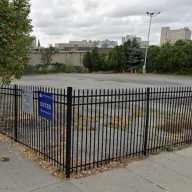The night ended with flames and fireworks bursting out of a miniature cruise ship as someone animatedly declared over a public address system, “This is the best country in the world! And the best city in the world! And the best borough in the city! And the best park in the borough!”
Two years after he propelled his homemade replica of a Revolutionary War-era submarine into New York Harbor, Duke Riley proved, yet again, that creativity and unpredictability are often intimate bedfellows.
With a flurry of imagination, a year of shipbuilding toil, and ample doses of inebriation on the part of toga-clad participants and spectators, the local artist transformed a Flushing Meadows-Corona Park reflecting pool into a Roman coliseum on Thursday, August 13.
Riley’s public art event, “Those About To Die Salute You,” was commissioned last year by the Queens Museum of Art (QMA). With a $12,000 budget, the spectacle pitted the staffs of QMA, the Brooklyn Museum, Manhattan’s El Museo del Barrio and the Bronx Museum against one another in a naval battle-cum-free-for-all that featured vessels made of recycled materials and putrid tomatoes and water balloons as ammunition.
“I expected it to be like the little boats they float in Central Park, like remote control,” QMA Director Tom Finkelpearl said with a dollop of laughter, a few hours before the event began. “I’ve seen projects grow before. But this is kind of remarkable.”
For about a year, Riley and a grassroots team of shipwrights salvaged old styrofoam and invasive reeds from area wetlands, fashioning the materials into reflecting pool-worthy crafts resembling everything from a 30-foot Spanish galleon to a shark-faced Staten Island ferry.
While some attendees snacked and trash-talked over heavy metal music in the museum’s foyer prior to the evening event, others battle-readied their ships, streaking a canoe in gold paint and arming a giant wooden pig with a fire hose.
The reflecting pool, filled for the first time in decades, was adorned with floating faux coliseum walls – a nod to the naumachia, a battle staged in flooded amphitheaters to pacify Roman emperors and the masses in times of economic strife.
The creativity on display, paired with the history lesson and economic relevance was, in the opinion of Long Island City artist China Marks, like “killing many birds with one stone – or maybe cooking the birds,” Marks noted with a knowing smile.
Marks’ insight into the quirky nature of artists and their performances proved clairvoyant when, as the sun ducked behind Manhattan, Queens’ largest park erupted in an epic, smoke- and confetti-filled extravaganza. Spectators leaped into the knee-deep pool as ships sailed into the “arena” propelled by “gladiators” and classic anthems like – aptly enough – Queen’s “We Will Rock You.”
The crowd – at least those not directly involved in the frenzy – stared, smiling and mouths agape, as museum curators darted across the pool, spears in hand, bodies accented with war paint, and devilish looks in their eyes.
Certain vessels quickly took on water and the sides of the shark ferry shook precariously. But Staten Island team member Oliver Jeffers, of Brooklyn, summed up the sentiment of those behind less water-savvy craft when he exclaimed earlier in the night, “Our success does not depend on capsizing.”
In the end, victory was achieved when a model of the Queen Mary 2 cruise ship – the vessel that attracted Riley’s makeshift submarine two summers ago and subsequently delivered him a rap sheet – capsized amid flotsam and battle cries. The four-foot flames and majestic fireworks that arced off its back sizzled in the pool’s choppy waters.
“Incredible,” “Insane,” “Awesome” – often preceded by expletives – emerged from the mouths of more than a few awed attendees.
Even the artist’s friends were dumbfounded.
“It’s one of the best of Duke’s performances yet,” said Ray Desouza, whose toga flickered in the pulsing glow of fireworks and was backlit by the towering Unisphere and the heroic bronze Rocket Thrower sculpture.
Finkelpearl, too, was duly impressed, noting that Riley’s creativity and imagination led to a more “exuberant” event than expected.
The next day, however, after a clean-up worthy of an emperor’s praise, the park was back to normal, according to Finkelpearl. No more ships ablaze, floating tomatoes or discarded togas. Just the lingering echoes of a mythical public performance remained.
“It looks like there’s about to be a golf tournament here or something,” Finkelpearl said.





























